Color teaching in video game environments. Influences of neuroarchitecture and cinema
DOI:
https://doi.org/10.18537/mskn.15.02.10Keywords:
video game, color, didactics, neuroarchitecture, cinemaAbstract
One of the objectives in the design of scenarios for video games is to introduce the player to an environment that generates stimuli. One of the mechanisms to achieve this goal is the use of color. The study of the influences of other arts such as architecture and cinematography has been used to finally address the use of color in the video game Virginia (Variable State, 2016). The analysis of different chromatic concepts such as gradient, tone, saturation, monochromatism or temperature, has materialized in the choice of conceptually opposed sequences in terms of their material application. Finally, we have been able to verify the intentions of the creators of the video game in terms of the design of the chromatic environment in which we develop our actions as players.
Downloads
Metrics
References
Albers, J. (2017). Interacción del color (M. L. Balseiro, Trad.). Alianza Editorial.
Anderson, W. (2014). El Gran Hotel Budapest [Película]. Fox.
Aumont, J. (2020). La imagen (S. Mattoni, Trad.). La Marca.
Baudrillard, J. (2006). Pantalla total (J. J. Solar, Trad.). Editorial Anagrama.
Berger, J. (1997). Algunos pasos hacia una pequeña teoría de lo visible. Ardora Ediciones.
Escribano Belmar, B. (2022). El videojuego como recurso potenciador de la creatividad y la conciencia cultural en la educación artística. En D. Escandell Montiel y J. F. Merchán Sánchez-Jara (Coords.), El videojuego como recurso pedagógico (pp. 61-82). Secretaría General Técnica. Centro de Publicaciones. Ministerio de Educación y Formación Profesional.
Gombrich, E. H. (2000). La imagen y el ojo. Debate.
Gubern, R. (1996). Del bisonte a la realidad virtual. Editorial Anagrama.
Heller, E. (2004). Psicología del color: Cómo actúan los colores sobre los sentimientos y la razón (J. C. Mielke, Trad.). Gustavo Gili.
Ito, T. (2000). Escritos (M. Suzuki, Trad.). Colegio de Aparejadores de Murcia.
Kieslowski, K. (1993). Tres Colores: Azul [Película]. MK2 Productions.
Krillbite Studio. (2019). Mosaic [Videojuego]. Raw Fury.
Labrador, E. (2020). El uso del color en los videojuegos. Héroes de Papel.
Ovosonico. (2017). Last Day of June [Videojuego]. 505 Games.
Rossi, A. (2019). Autobiografía Científica (M. P. Rodríguez, Trad.). Editorial Gustavo Gili.
Tanizaki, J. (2014). El elogio de la sombra (J. Escobar, Trad.). Siruela.
Thiébault-Sisson, F. (2010). Claude Monet, an Interview: 1900. Kessinger Publishing.
Tournier, M. (2000). El espejo de las ideas (L. M. T. Vila, Trad.). Editorial Acantilado.
Variable State. (2016). Virginia [Videojuego]. 505 Games.
Published
How to Cite
Issue
Section
License
Copyright (c) 2024 Luis I. Barrero

This work is licensed under a Creative Commons Attribution-NonCommercial-ShareAlike 4.0 International License.
Copyright © Autors. Creative Commons Attribution 4.0 License. for any article submitted from 6 June 2017 onwards. For manuscripts submitted before, the CC BY 3.0 License was used.
![]()
You are free to:
 |
Share — copy and redistribute the material in any medium or format |
 |
Adapt — remix, transform, and build upon the material for any purpose, even commercially. |
Under the following conditions:
 |
Attribution — You must give appropriate credit, provide a link to the licence, and indicate if changes were made. You may do so in any reasonable manner, but not in any way that suggests the licenser endorses you or your use. |
| No additional restrictions — You may not apply legal terms or technological measures that legally restrict others from doing anything the licence permits. |









